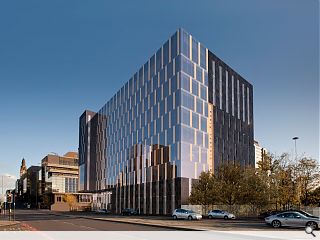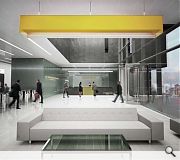St Vincent Plaza secures planning consent
February 6 2012
Planning permission has been awarded to a 170,000sq/ft speculative office scheme on Glasgow’s St Vincent Street – with the developer promising to commence enabling works “within the next few weeks”.St Vincent Plaza, proposed by Abstract (Glasgow) Ltd and comprising 12 floors of Grade A office space at a key gateway to Glasgow’s CBD.
Mark Glatman, Chief Executive of Abstract Securities, said: “Glasgow City Council has recognised that in order to attract yet more big-name corporates to the city, it is imperative that Glasgow can offer high-quality 'Grade A' office accommodation at an achievable cost. St Vincent Plaza is all about offering value at a time when occupiers have to keep a very close eye on the bottom line and cannot justify heavy costs.
“By coming to the market with a top-quality product and quoting rentals from £23 per sq. ft. we are significantly undercutting the established Glasgow market and offering exceptional value for money as well as significantly reduced operational costs. We are offering a very rare opportunity to take 'Grade A' space that costs less than some second hand space in Glasgow.”
Keppie Design are acting as architects on the scheme whilst Bowmer & Kirkland have been appointed as main contractor.
Project completion has been penciled in for Autumn 2013.
14 Comments
#1 Posted by Boss on 6 Feb 2012 at 18:43 PM
Christ. Glasgow council really will approve anything. Nothing like a little desperation to spur redevelopment and try float an invisible market. Between this and Collegelands, the city centre has become a dumping ground for uninspiring buildings. I wont even merit either of them with the term, architecture.
#2 Posted by Brian on 7 Feb 2012 at 13:00 PM
I also think its very dull.
#3 Posted by Local on 7 Feb 2012 at 13:24 PM
I think it looks great. A big modern glassy building, perfect for its location. Think it will improve the street scene at this part of town. Its received 100% support from me. I accept I am not an architect and merely a local resident with an opinion but having discussed this with my friends who live locally, they all like it and I am sure there are more non architects living in this area than architects. So if you dont like it, stop moaning about and get back to work and design something better.
#4 Posted by Ross on 7 Feb 2012 at 22:05 PM
When people come to Glasgow they stop and stare at its magnificent buildings - its many reasons why people and many architects visit. If we build the same old same old glass sheet metal cladding monolithic block that could be confused with a fancy NCP car park, what's the point in visiting? May as well be in any other city. What's the point in Glasgow winning city of architecture and design 1999? Glasgow need to keep its buildings bursting with personality, innovative and inspiring! To leave a future legacy like our Edwardian and Victorian predecessors did.
#5 Posted by KJP on 7 Feb 2012 at 22:23 PM
#3 Local? I doubt it. The building lacks finesse but it is not brutal like the new RSAMD extension on the other thread, the impression it gives is that it has been conceived by a junior member of the archietct team
#6 Posted by KJP on 7 Feb 2012 at 22:25 PM
sorry the RSNO, still who can tell the difference. It's still damn ugly
#7 Posted by Neil on 8 Feb 2012 at 09:25 AM
Small point but can developers please stop calling buildings 'plaza'? a) this isn't a plaza and b) it sounds hopelessly 90s, in a capuccinos 'n' tapas regeneration kind of way.
#8 Posted by Jimbob Tanktop on 8 Feb 2012 at 10:30 AM
It is ugly, but then it's a lifeless part of the city, full of other ugly, utilitarian buildings (though I do like the Britoil building...).
If the economy had been in better shape maybe something of a higher quality could have injected some sparkle into the district, but it's obviously a cheap and cheerful offering and designed to a budget, so it's as remarkable as could be expected.
Concerned that the much more prominent site across the road will suffer a similar fate though.
If the economy had been in better shape maybe something of a higher quality could have injected some sparkle into the district, but it's obviously a cheap and cheerful offering and designed to a budget, so it's as remarkable as could be expected.
Concerned that the much more prominent site across the road will suffer a similar fate though.
#9 Posted by stacey on 8 Feb 2012 at 12:39 PM
Neil - totally agree about the 'plaza' posturing but in a funny way it suits it, or as some would say, "it's in-keeping with".
#10 Posted by david nimmo on 8 Feb 2012 at 16:20 PM
Yes it could just as easily be anywhere in the CBD in Sao Paulo but maybe people will feel nostalgic for that kind of thing one day. I don't know if there is any public money in this, but as a speculative development in the current climate, it seems to be a pretty brave step.
#11 Posted by david nimmo on 9 Feb 2012 at 11:59 AM
Isn't 'Plaza' an American affectation introduced in the '60's, about the same time as 'Atrium'? I would have thought that we are well past the time when use of the word conferred any positive connotations whatsoever if it ever did. A Piazza I get. The only Plaza reference that occurs to me is Dealey Plaza, Dallas. The well known building there is the dull looking book depository allegedly used by the alleged assassin to shoot JFK.
#12 Posted by kevin toner on 27 Feb 2012 at 14:55 PM
I have to concur with post #3, but not all the way!
Whilst St Vincent St. is addressed with a commendably glassy frontage, the lack of modelling to the rest of the proposal in addition to the use of alien materials [save Tay House, which is similarly clad in metal] denies the responsibility and privilege of being sited in a very crucial part of the already well established 1960s Seifert masterplan.
This partial ignorance is undoubtedly an economic concession that the planners have had to accept!
Whilst St Vincent St. is addressed with a commendably glassy frontage, the lack of modelling to the rest of the proposal in addition to the use of alien materials [save Tay House, which is similarly clad in metal] denies the responsibility and privilege of being sited in a very crucial part of the already well established 1960s Seifert masterplan.
This partial ignorance is undoubtedly an economic concession that the planners have had to accept!
#13 Posted by kevin toner on 27 Feb 2012 at 20:59 PM
The one consolation in contextual terms is that Tay house will now have an ally on this [northbound] stretch of the ring road. Not perhaps a bad thing!
There are of course 2 other fairly close buildings with metal cladding that offer concern.
The Whyte & McKay building opposite the Britoil building, although applying the material at the rear, exhibits a similar missed opportunity to harmonise with the lustre (mainly polished stone/glass) of Holland Street’s T-junction with St Vincent St. A Google street view looking towards the Britoil building from the Holland St / West George Lane junction reveals this particular instance.
The Eagle building; the Britoil building; the front of the W&McK building; the Hilton tower are all awaiting a repeat of this mistake.
However, the clash at Holland Street is not visible to the world in the same way. This view might one day be corrected, as part of an urban block, whereas the Plaza development leaves no room for manoeuvre.
Even Heron House [re-clad job] has done well to obscure the portions of metal cladding facing the approaching traffic coming from the off-ramp ergo contributing to the lustrous entrance into the CBD.
Would maintaining the principle at this axial point be asking too much? I think the answer would be “no” going on the previous comments in respect of the site’s speciality!
[As Heron Ho. among other re-clad 1960s buildings have been mentioned earlier, and as Glasgow seeks to ‘preserve/enhance’ her ‘character/appearance’, why is natural stone not figuring as a possible option? The contentiousness of thin stone in newbuild is probably inapplicable; and further still, relatively heavy stone might be as inexpensive as typically applied cladding (?)]
There are of course 2 other fairly close buildings with metal cladding that offer concern.
The Whyte & McKay building opposite the Britoil building, although applying the material at the rear, exhibits a similar missed opportunity to harmonise with the lustre (mainly polished stone/glass) of Holland Street’s T-junction with St Vincent St. A Google street view looking towards the Britoil building from the Holland St / West George Lane junction reveals this particular instance.
The Eagle building; the Britoil building; the front of the W&McK building; the Hilton tower are all awaiting a repeat of this mistake.
However, the clash at Holland Street is not visible to the world in the same way. This view might one day be corrected, as part of an urban block, whereas the Plaza development leaves no room for manoeuvre.
Even Heron House [re-clad job] has done well to obscure the portions of metal cladding facing the approaching traffic coming from the off-ramp ergo contributing to the lustrous entrance into the CBD.
Would maintaining the principle at this axial point be asking too much? I think the answer would be “no” going on the previous comments in respect of the site’s speciality!
[As Heron Ho. among other re-clad 1960s buildings have been mentioned earlier, and as Glasgow seeks to ‘preserve/enhance’ her ‘character/appearance’, why is natural stone not figuring as a possible option? The contentiousness of thin stone in newbuild is probably inapplicable; and further still, relatively heavy stone might be as inexpensive as typically applied cladding (?)]
#14 Posted by kevin toner on 27 Feb 2012 at 22:04 PM
There’s of course a dogma for cladding systems over loadbearing stone construction, in respect of newbuild, that has plagued much of our mainstream neo-modernist post-war architecture.
Perhaps modernism will do well to rediscover this [forgotten construction option] to help it partake in such historic environments as Glasgow!
Anti-modernism possibly has strong grounds in this respect.
Roger Scruton is incidentally lecturing on “A Philosophical Assessment of Our Contemporary Architecture” as part of the AHSS Winter Lecture Series 2011/2012 shortly.
Perhaps modernism will do well to rediscover this [forgotten construction option] to help it partake in such historic environments as Glasgow!
Anti-modernism possibly has strong grounds in this respect.
Roger Scruton is incidentally lecturing on “A Philosophical Assessment of Our Contemporary Architecture” as part of the AHSS Winter Lecture Series 2011/2012 shortly.
Post your comments
Read next: Skanska advance HMP Grampian plans
Read previous: SDA chair issues address to nominees
Back to February 2012
Like us on Facebook
Become a fan and share
News Archive
Search News
Features & Reports
For more information from the industry visit our Features & Reports section.




